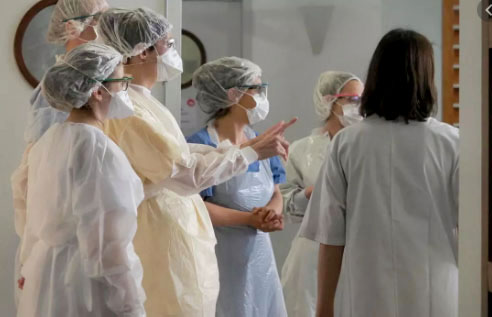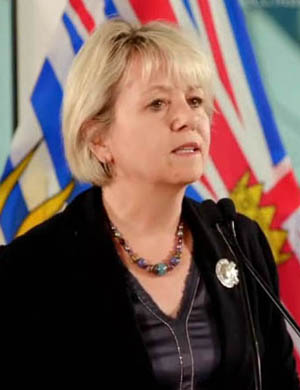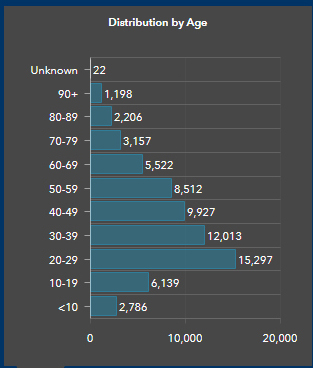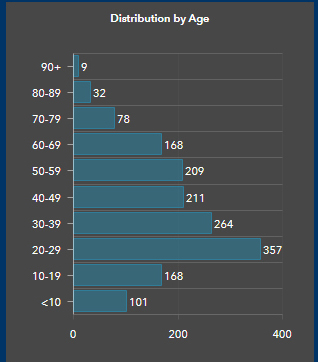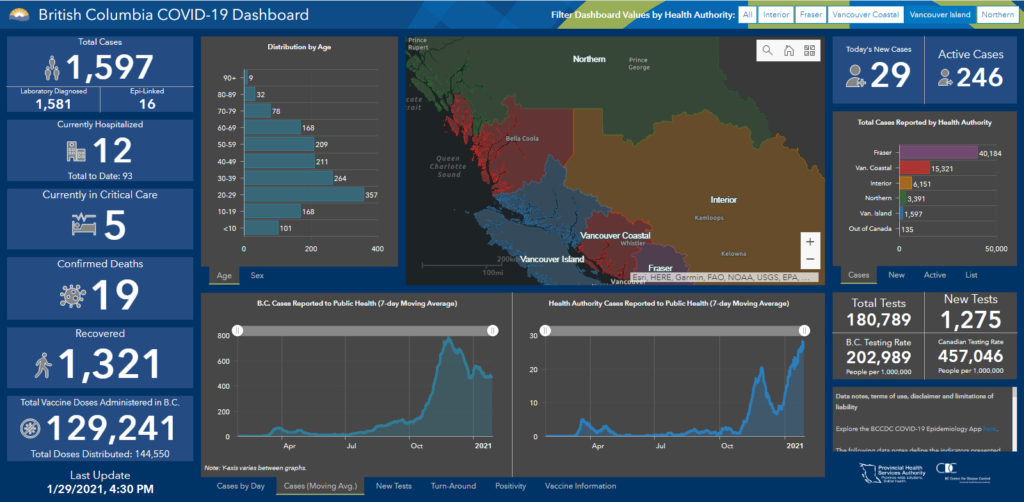
Saturday January 30, 2021 | VICTORIA, BC
by Mary P Brooke, B.Sc., Editor | Island Social Trends
“COVID lives to spread,” said Health Minister Adrian Dix on Friday, noting it was “one year and one day” since COVID-10 was acknowledged as active in British Columbia.
“It’s never too late to join our effort,” said Dix, addressing anyone in BC who hasn’t yet decided to fully adhere to public health orders and protocols that are designed to keep everyone safe during the ongoing infectious pandemic.
Protecting the health-care system has been paramount for Minister Dix during the pandemic, with the strategic management of the pandemic by Provincial Health Officer Dr Bonnie Henry as the key force in achieving that. Hospitalization for COVID-19 has plateaued (though at a high level) in the last week or so, a good sign. Without a strong and resilient force of front-line health-care workers, the battle against severe infections would be impaired.
Doctors, nurses, support personnel in many areas of hospital and health-care function are all key players in maintaining support for anyone who finds themselves in serious condition with a COVID infection. Minister Dix reports weekly on the number of available beds in hospitals for both regular care and COVID patients.
There have been 3,757 hospitalizations in BC to date due to infection with the SARS-CoV-2 (COVID-19) virus. The virus continues to mutate, and the variant strains appear to be more contagious and possibly capable of producing more serious disease; currently found to be circulating in BC are the B.117 (UK) strain and B.1351 (South African) strain, and there is a Brazil strain being found in Canada as well.
Vaccine profile:
Vaccines of the mRNA type (known as by the names of their manufacturers, i.e. Pfizer-BioNTech and Moderna) are being administered in BC from a federally-secured supply that is being distributed to all provinces and territories in Canada. Coming onstream (if approved by Health Canada) are vaccines by AstraZeneca, Johnson & Johnson, and Nova. “We will be using them in people with whom they work best,” said Provincial Health Officer Dr Bonnie Henry regarding administration of COVID-19 vaccines in BC in her media session yesterday.
The Pfizer and Moderna vaccines solidly follow a two-dose regimen for best results. Dr Henry has remarked several times how ‘remarkable’ and ‘amazing’ that it is that there are vaccines at all, let alone to the degree that the mRNa vaccines are effective against infection and severity of illness. Indeed, in context, this is somewhat suddenly the ultra-modern age when it comes to human disease management.
She notes, in particular, that it’s amazing that the mRNA vaccines work so well in older people. “That’s novel, and one of the most positive thing that we have”, in the fight against COVID-19 in the elderly population.
One of the advantages of the Johnson & Johnson vaccine is that it only requires a single dose, says Dr Henry; while the level of protection might be lower (70%) it eliminates the need to track down recipients for a second dose. It might be highly useful in situations where people need fast but short-term resistance to the virus, such as suddenly being called into an active health-care management situation.
The Nova vaccine is in Phase 3 trials, and so far is indicating good overall efficacy (90%), but less so against the South African variant, says Dr Henry.
Notably, the AstraZeneca vaccine works better in younger people, Dr Henry said on Friday.
“Without a vaccine, we don’t get through this pandemic,” said Prime Minister Justin Trudeau last fall before vaccines were even on the active scene. “We will not cut any corners when it comes to protecting Canadians’ safety,” he said in a media session on November 24, 2020.
Transmission high in workplaces:
Orders remain in place in BC that restrict socializing to household-only. Everyone is expected to continuing wearing masks in all indoor public spaces (including workplaces), and maintaining physical distance in all public places.

About 40% of COVID infections are related to workplaces, not so much from public interface, said Dr Henry yesterday. “People working together” is the source of the transmission. People let their guard down in lunch periods and break rooms, or before and after work. Transmission is high in food processing plants, she noted, adding that outbreaks can be contained if caught early.
Travel continues to be limited to essential-only (for work or medical appointments). The federal government has also now imposed (coming up effective February 1, 2021) a mandatory 3-day quarantine upon returning from any location outside of Canada while test results are awaited (in an “approved hotel” and covering all their own costs which are expected to be around $2,000), and then the person must fulfill the remaining days of a 14-day quarantine at home in self-isolation.
“COVID-zero is not a reality for a jurisdiction such as ours,” says Dr Henry, in comparison to places like Atlantic Canada where with a few borders and access points the flow of people in-and-out can be controlled. In BC there are so many points of entry and exit that it would be nearly impossible to enforce, said Premier John Horgan earlier this week.
===== COVID stats for BC (at January 29, 2021)
Total cases to date in BC: 66,779 and presently 4,557 of those are active. Presently 7,242 people are self-isolating following known exposure to someone who is infected or a known outbreak.
There are 292 people in hospital due to COVID-19 (74 in ICU).
Among long-term care and assisted-living residents and staff there are 1,446 infections (926 residents and 520 staff).
Now 59,551 people are called recovered “to various degrees” (after previously testing positive), says Dr Henry, with one of her first references to long-haulers (people with ongoing health impacts due to COVID-19 infection).
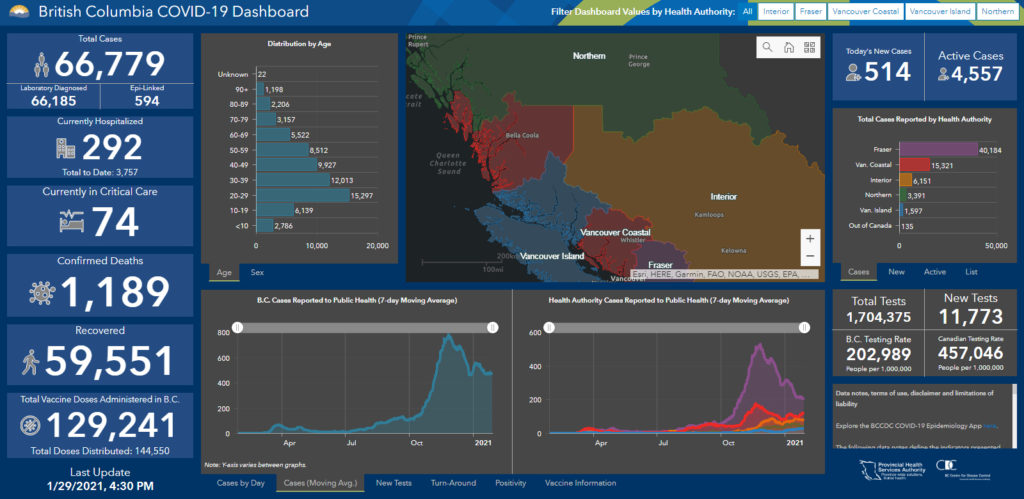
To date, 1,189 people have died due to the COVID-19 infection (five in the last 24 hours).
In total, 129,241 doses of the mRNA vaccine types have been administered in BC, from a total supply of 144,550 (103,350 Pfizer and 41,200 Moderna).
The first dose of COVID-19 vaccines have now been provided to long-term care residents and staff who would like it. “While this protection for those who are most vulnerable is an important milestone for us all, we must continue to remain vigilant,” says Dr Henry.
Children and teens are still not eligible for vaccines, due to no clinical data from vaccine trials for ages up to 18 years. However Phase 4 of the BC Immunization Plan will include 18-year-olds, presently that being scheduled for September 2021. Dr Henry has noted in the past that most of the case numbers in the 10 to 19 age group are actually among people ages 18 and 19 who are essentially in adult lifestyles (work, post-secondary, social, etc).
Phase 4 of the BC Immunization Plan: July to September 2021
- People aged 59 to 18, in five year increments:
- 59 to 55 (D1 July, D2 August)
- 54 to 50 (D1 July, D2 August)
- 49 to 45 (D1 July, D2 August)
- 44 to 40 (D1 July, D2 August)
- 39 to 35 (D1 July/August, D2 August/September)
- 34 to 30 (D1 August, D2 September)
- 29 to 25 (D1 August/September, D2 September)
- 24 to 18 (D1 and D2 September)
As of January 29 there have been 2,786 children under age 10 who have tested positive for COVID-19 (23 in the last 24-hour report), which is 4.2% of all infections in BC. Now 6,139 youth ages 10 to 19 have tested positive for COVID-19 (161 in the last 24-hour period); that’s 9.2% of all infections pandemic-to-date.
The highest number of cases by 10-year grouping are among people in their 20s: a total of 15,297 cases to date (22.9% of total cases pandemic-to-date). People in their 30s are the next-highest group in terms of test-positive cases: a total of 12,013 cases to date (18%). The high case level for these age groupings is from socializing and also being active in the workplace, particularly including COVID-frontline employment situations.
===== COVID stats for Vancouver Island (at January 29, 2021)
Total cases to date on Vancouver Island (in Island Health): 1,597 and presently 246 of those are active.
There are 12 people in hospital due to COVID-19 in Island Health (five in ICU).
On Vancouver Island, now 1,321 are called recovered “to various degrees” says Dr Henry, with one of her first references to long-haulers (people with ongoing health impacts due to COVID-19 infection).
To date, 19 people have died on Vancouver Island due to the COVID-19 infection (two in the past week).
In total, 27,900 doses of the mRNA vaccine types have been received in Island Health. Of those, 21,583 have been administered in Island Health (just two of those being a second dose), with 57 of those done in the 24 hours between Thursday and Friday of this past week.
As of January 29 there have been 101 children under age 10 who have tested positive for COVID-19 in Island Health (two in the last 24-hour report), which is 6.3% of all 1,597 infections on Vancouver Island to date. Now 168 youth ages 10 to 19 have tested positive for COVID-19 on the island (four in the last 24-hour period); that’s 10.5% of all Vancouver Island infections pandemic-to-date.
Similar to the all-BC numbers, the highest number of cases by 10-year grouping on Vancouver Island is among people in their 20s: a total of 357 cases to date (22.3% of total Vancouver Island cases pandemic-to-date, which is almost the same as BC-wide). People in their 30s are the next-highest group in terms of test-positive cases: a total of 264 cases to date (16.5%, which is a bit lower than BC-wide). The high case level for these age groupings is from socializing and also being active in the workplace, particularly including COVID-frontline employment situations.
People in their 40s and 50s on Vancouver Island are now pretty much on par for number of cases: 211 and 209 respectively (each around 13.2% of island cases). The BC-wide case count shows more people in their 40s (14.7% of BC cases) with infections than in their 50s (12.7%).




